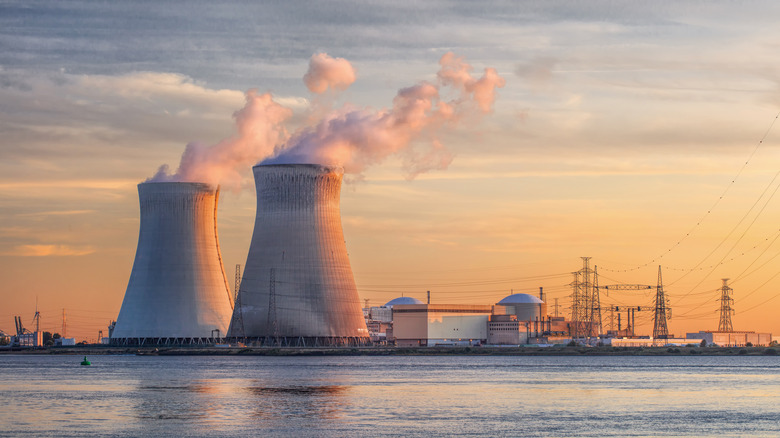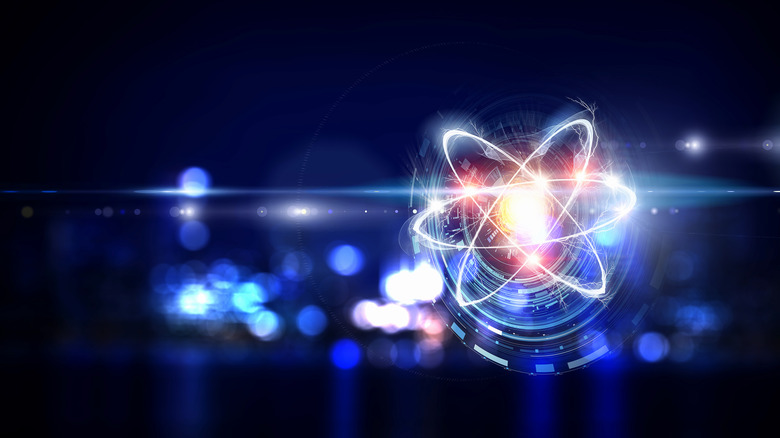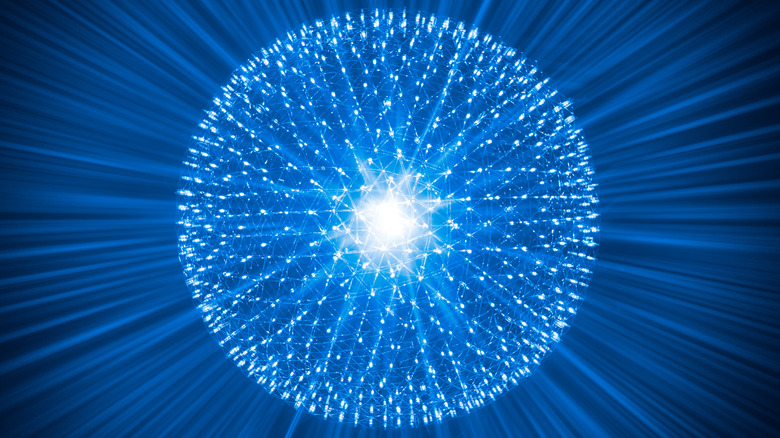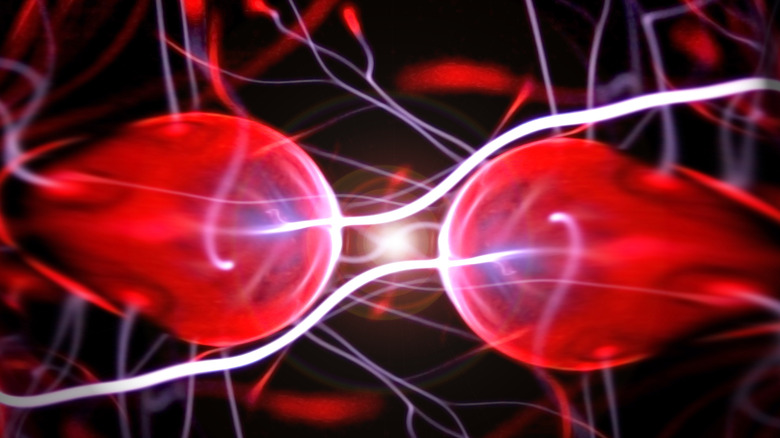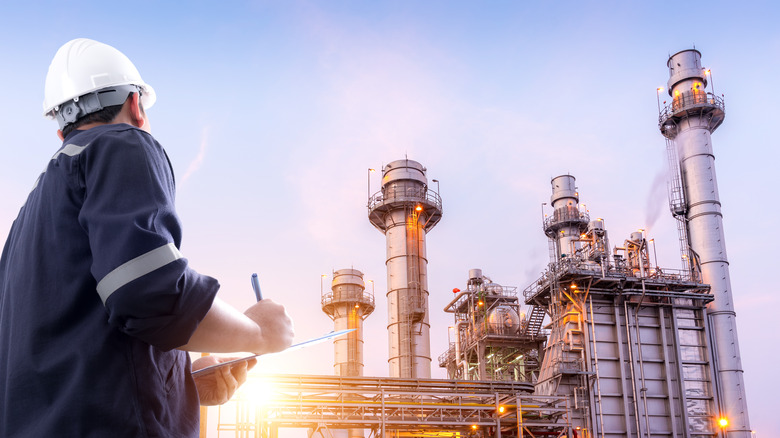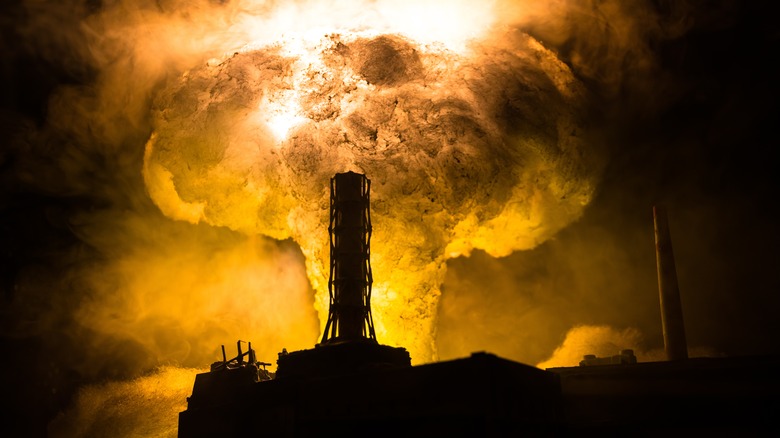The Biggest Differences Between Nuclear Energy And Atomic Energy
Atomic energy and nuclear energy are terms that are often used interchangeably, but are they actually the same thing? They are both defined by their relation to the parts of an atom. Atoms include a nucleus and an electron cloud around the nucleus. The nucleus is made up of subatomic particles, protons, and neutrons. Each has different electrical charges: Protons are positive, electrons are negative, and neutrons have zero charge. This affects their interactions with each other (via Britannica). Energy is what holds all the parts of the atom together.
Both nuclear and atomic energy can be part of the process of creating electricity in a nuclear power plant. The biggest difference between them, as it turns out, is that atomic energy includes the energy needed to hold electrons in their orbitals in the atom. Nuclear energy does not, according to Pediaa. However, that's not the only difference between them.
Atomic vs. nuclear energy
Atomic energy is the amount of energy an atom holds. It includes the potential energies of all subatomic particles as well as the energy required to maintain atoms in a chemical bond when they are in compounds, called inter-atomic energy. The energy needed to split an atom into free electrons and a nucleus, called ionization energy, is also contained within the term atomic energy (via Pediaa).
On the other hand, nuclear energy does not include inter-atomic or ionization energy, according to Pediaa. It's defined as the total energy of the nucleus of an atom and is released when nuclear reactions occur. These reactions change the nucleus of an atom in one way or another. There are two major types of nuclear reactions: fission and fusion.
Other terms associated with atomic and nuclear energy are nuclear binding and potential energy. Nuclear binding energy is what is required to split the nucleus into neutrons and protons, or approached from the opposite direction, it's what binds neutrons and protons together in a nucleus. This is involved in nuclear fission. Potential energy of the nucleus is the combination of the potential energies of all subatomic particles in a nucleus. It is not destroyed when nuclear splitting occurs (via Pediaa).
Nuclear fission
Nuclear fission occurs when something causes the nucleus of an atom to split into smaller particles. The particles are called fission products. The total mass of the fission products will be less than the initial mass of the nucleus. The extra mass is converted to energy, which can be explained by Albert Einstein's famous equation, E = mc2. E is the energy produced by the fission, m is the missing mass, and c is the speed of light (via Pediaa).
Nuclear fission can happen in different ways. One is by radioactive decay, a process that stabilizes previously unstable nuclei. During this process, protons and neutrons can become different types of particles. Another way fission can occur is through neutron bombardment, which is when a neutron hits a nucleus from the outside, often causing the nucleus to split. These resulting particles are also called fission products (via Pediaa).
This process releases a lot of energy, and the resulting energy becomes heat and radiation, according to the International Atomic Energy Agency (IAEA). A nuclear power plant can turn this heat into electricity. In such a power plant, the heat warms a nuclear reactor's cooling agent, usually water, turning it into steam, which then powers turbines to generate electricity.
Nuclear fusion
Nuclear fusion is essentially the opposite of nuclear fission, in that a nucleus becomes bigger through the fusion process. This occurs when two nuclei merge to become one. The new nucleus is heavier than the original two, but it has less mass. Because the total mass of the new nucleus is less than that of the two original nuclei, this process also creates energy and can again be explained by E = mc2, according to the U.S. Department of Energy (DOE). This can only happen within plasma, a hot gas made of positive ions and free-moving electrons. It is different from other gases and other states of matter like solids and liquids.
Fusion can happen with many different elements on the periodic table, but scientists are particularly interested in the deuterium-tritium fusion reaction. This reaction produces a neutron and a helium nucleus and releases much more energy than most fusion reactions. It also occurs at lower temperatures than fusion reactions of other elements (via the DOE).
According to the International Atomic Energy Agency (IAEA), nuclear fusion powers the sun and other stars, but those reactions occur only at extremely high temperatures — about 10 million degrees Celsius. The high temperatures give the nuclei enough energy to push past their electrical repulsion and fuse. The nuclei must be in a very small space for this to happen. The sun's gravity creates the pressure needed for fusion.
Pros of using nuclear power
One of the benefits of using nuclear power here on Earth is that it's good for generating electricity and has a higher energy level than fossil fuels (via Pediaa). The U.S. Office of Nuclear Energy, which researches maintenance of existing reactors and technology for future ones, notes that the nuclear power industry employs about half a million people in the U.S. and adds about $60 billion to the U.S. GDP every year. An American nuclear power plant can employ as many as 700 workers, with higher than average salaries.
The Office of Nuclear Energy also points out that nuclear power is the largest source of clean, or non-carbon-producing, energy in the U.S. Nuclear power generates many hours of electricity each year. This eliminates the creation of over 470 million metric tons of carbon each year, equivalent to taking 100 million cars off the road. Globally, nuclear power creates around one-third of the world's carbon-free electricity (via the IAEA). Nuclear power in the U.S. is also important to maintaining international security, according to the Office of Nuclear Energy, because the U.S. needs to be a global leader in this field, working with other countries to ensure the peaceful use of nuclear technology.
Cons of using nuclear power
Nuclear power can be expensive to operate, partially because of strict rules about maintenance, staffing, training, and inspections. The Department of Energy (DOE) is working to reduce these costs while making sure performance improves rather than suffering from any changes. They are also developing "accident tolerant fuels," which would produce less waste and could be in use by 2025, according to the Office of Nuclear Energy.
The transportation and storage of used fuel from nuclear power plants is often complicated. At present in the U.S., it's stored at 76 sites in 34 states. Congress is working on ideas about permanent disposal. The DOE is designing a new type of train car for large-scale transportation of used fuel from plants (via the Office of Nuclear Energy).
Disasters at power plants globally have caused public concern about the use of nuclear energy. Nuclear power plants produce nuclear waste with different levels of radioactivity. Its storage or disposal is different, depending on the level of radioactivity and its purpose, according to the IAEA. The DOE is working on the design of advanced reactors, using new technology, that should generate much less nuclear waste. These may be under construction by 2030 (via the Office of Nuclear Energy).
